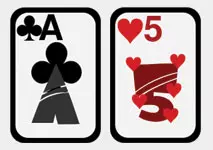Blackjack Hands
Blackjack is easily the most popular house-banked card game in the world and, as such, is available in multiple variations across all land-based and online casinos. Learning the rules is relatively simple, but mastering the game extends far beyond that. Learning the ins and outs of basic blackjack strategy is vital for all savvy players looking to reduce the house edge, improve their winning odds, and minimize their losses.
It all starts with a basic understanding of the main types of blackjack hands, as without it, you will never be able to make the mathematically correct playing decisions. In this article, we walk you through soft and hard hand totals in blackjack and cover the five main moves available to players (hitting, standing, splitting, doubling down, and surrendering). We finish with a quick rundown of the worst blackjack hands you should always surrender and explain the reasoning behind this move.
-
 Sign Up Bonus
Sign Up Bonus
Up to $500
400% Bonus!9.7 -
 Sign Up Bonus
Sign Up Bonus
Up to $3500
350% Bonus!9.4 -
 Sign Up Bonus
Sign Up Bonus
Up to $2000
200% Bonus!9.3
Basic Rules of Play
Blackjack is a house-banked casino game where players are pitted against the dealer rather than competing against each other. A standard blackjack table can typically accommodate one to seven players at a time. Before we proceed, we should also point out that the playing decisions of other patrons participating in the game do not impact your winning odds or the outcome of your hand. This is a common misconception among unskilled players who incorrectly assume that a single person’s poor playing decisions can cause the entire table to lose.
The game starts with the dealer shuffling the cards and burning the top card by placing it at the bottom of the deck. Depending on the policies of the respective casino, the dealer may or may not show the burned card to the players. Everyone at the table, including the dealer, receives two cards that constitute their starting hands. Players get their cards face down in single-deck and double-deck blackjack variations.
This is not the case in “shoe” games with four to eight decks where players receive their starting cards face up and are prohibited from touching them. The dealer receives their first card face up, but their second “hole” card is facedown.
The objective of players is to beat the dealer in one of three ways. You can win by outdrawing the dealer with a higher hand total without going over 21, or by getting a hand total of 21 (blackjack) with your first two cards. The dealer can also lose to players by busting with a hand value that exceeds 21. Once everyone receives their initial two cards, patrons can choose from several playing decisions.
They can either hit (draw more cards from the deck or shoe) or stand (decline drawing additional cards). Depending on the house rules and their starting hand total, players can also split paired cards of equal value or double down by increasing their initial wager in exchange for one more card. Both splitting and doubling require making additional bets, as you shall see later.
Only the face value of cards matters in blackjack, where card suits are largely irrelevant. Cards 2 through 9 count at their pip value, which means their value corresponds to the number of pips printed on top. Tens of any suit and face cards (Jacks, Queens, and Kings) all count as tens. Aces have a flexible value in blackjack as they count either as 1 or 11, depending on which value is more beneficial for the player at a given moment.
If both the player and the dealer obtain the same hand total, the round results in a push and no one wins or loses – players get their initial wagers back. If the player outdraws the dealer, they receive an even-money payout (1 to 1). This payout usually increases to 3 to 2 for player blackjacks that consist of a ten-value card and an ace. The player gets one and a half times their original bet in this case.
When the dealer’s exposed card is an ace, the player can take insurance by making a side bet equal to half their initial wager. The dealer will then peek under their hole card to check for a blackjack. Several outcomes are possible in this instance. If the dealer indeed has a blackjack but the player does not, the player loses their main wager, but their insurance bet wins at odds of 2 to 1. Assuming the dealer has no blackjack, the insurance bet loses and play proceeds as usual, with the player hitting, standing, splitting, or doubling, depending on their starting total. Some variations support the late surrender rule, allowing the player to forfeit their initial two-card total by giving up half their original wager.
The dealer is always the last person at the table to act on their hand, which gives the house a considerable edge over players. This advantage is partially offset by the fact blackjack dealers must play by fixed house rules that require them to draw to at least 16 and stand on 17 or above. Unlike players, dealers cannot split pairs, double down, or surrender, which slightly takes away from their advantage. The standing rules for the dealer may differ depending on what you play and where. Some blackjack variations require the dealer to stand on all totals of 17. In others, the dealer must hit soft 17, and this is disadvantageous for players since it slightly increases the house edge.
Soft vs. Hard Hands
Aces are the most important cards in this game because they help you form blackjacks and have a flexible value. There are two main types of hands in the game: soft and hard. Soft totals are more advantageous for players since they contain aces that can count either as 1 or 11. For example, a starting hand containing an ace next to a 4 can have a total of 5 or 15 and remains soft until the player eventually draws a card that causes the ace to lose its flexibility. If the player draws a 10, for instance, the ace will count as 1 to prevent them from busting. Their soft hand will automatically turn into a hard 15 in this case.
Soft hands benefit the players because it is impossible to bust with them on the next hit. The only exception to this rule is a blackjack where you have an ace next to a ten-value card as your starting hand. In shoe games where players receive their cards face up, blackjacks automatically stand rather than having flexible totals of 1 or 21 as the dealer assumes a hand value of 21 by default. While it is technically possible to hit blackjacks in single-deck games where players’ cards are facedown, no person in their right mind would draw on this hand.
Conversely, hard hands either do not include an ace or have an ace with a fixed value of 1. For instance, a hard 17 can consist of [9][8], [10][3][4], or even [A][6][K]. In this last case, the player started the round with a soft 17 but drew a ten-value card, causing their ace to lose its flexibility. Some of the worst starting hands players can possibly get in blackjack consist of hard totals.
Stiff Hands
 In blackjack, the term “stiff” or “hard” hand refers to any hand that could bust if the player takes one more card. To be more precise, hard hands have no aces or their aces count as 1. In essence, hard hands are those with totals of 12 through 20. Hard totals containing two cards of the same value are considered pairs and call for a different strategy in some cases.
In blackjack, the term “stiff” or “hard” hand refers to any hand that could bust if the player takes one more card. To be more precise, hard hands have no aces or their aces count as 1. In essence, hard hands are those with totals of 12 through 20. Hard totals containing two cards of the same value are considered pairs and call for a different strategy in some cases.
The two worst starting hands a player can possibly get are hard 15 and hard 16 against strong dealer upcards 9 through ace. Standing is far from optimal in this case, as the average winning total in blackjack is around 18.5 and the player risks being outdrawn if they don’t hit. To add insult to injury, hard 15 and hard 16 have the highest probabilities of busting when hit, so drawing more cards to them is also not the optimal decision in most cases. Surrendering is the least disadvantageous way to play these hard totals against dealers showing high upcards, but more on this later.
Splitting Pairs
Players can split pairs of two cards sharing the same value, such as [7][7]. When splitting, the player must make an additional bet equal to their initial wager. Once the pair is split, the player receives one extra card to form two hands and plays them separately as usual. Paired aces are the only exception to this rule. Each split ace receives no more than one card, as most casinos prohibit hitting split aces.
Splitting pairs can be advantageous for the player, but it all depends on the specific pair and the value of the dealer’s upcard. Here are a few basic rules to follow:
- Players should always split paired aces, in which case they receive one extra card on each ace. If they draw a ten-value card next to a split ace, the hand counts as a regular 21 instead of blackjack and pays even money if it wins. Only starting two-card totals that add up to 21 count as blackjacks and are eligible for the higher payout of 3 to 2.
- Paired 8s are always split, and for very good reason. As we previously mentioned, hard 16 is one of the worst starting hands in blackjack, as it has a high bust probability and low odds of winning if you stand on it. If you split your 8s, you cannot bust on your very first hit, and you have an opportunity to improve your situation.
- Players should always resplit their aces and 8s if the rules at the respective table allow it. Most online blackjack variations enable players to split up to three times to form four separate hands.
- You should never split paired ten-value cards like [10][K], [10][10], or [Q][J]. Such pairs already give you a solid starting hand, so why ruin it?
- Splitting 5s is just as bad because it often results in players getting stuck with two subpar hard hands with lower winning odds. Obtaining a total of 10 is a great way to start a round in blackjack and always calls for either hitting or doubling down, depending on the value of the dealer’s upcard.
Doubling Down
Doubling down is possible only after the initial draw when players obtain the first two cards that form their starting hands. When you make this move, you double your original wager and receive one more card in exchange. Players cannot take additional cards after they double down.
Doubling down is mostly recommended against dealers in a weak position, as it enables you to extract more value from solid starting hands. Simply put, this helps you win more money when you find yourself in an already favorable situation. It has nothing to do with improving your starting hand. Here are some basic doubling rules to follow, but keep in mind the fixed standing rules for the dealer also impact certain basic strategy plays.
- In multi-deck games where the dealer stands on soft 17, players should double on 11 against all dealer upcards except an ace. Doubling on 11 versus the dealer’s ace is recommended only in variations where the dealer must hit soft 17.
- Basic strategy recommends doubling down on totals of 10 against dealers showing cards 2 through 9 regardless of the fixed house rules. Doubling is also optimal with starting totals of 9 against weak upcards 3 through 6, as the dealer has higher chances of busting in this case.
- Players must double on soft totals of 13 through 18 against a dealer showing a 5 or 6. In multi-deck variations where the dealer hits soft 17, players should also double on soft 19 against a 6.
Late Surrender in Blackjack
Some online blackjack variations support the late surrender rule whereby players can fold weak starting hands by forfeiting half of their initial wagers. Some people frown at the idea of losing half a bet, but this is the optimal choice for hands that have low probabilities of winning. As a rule of thumb, basic strategy recommends late surrender for starting totals whose probability of losing exceeds 50%. Hard 16 is a notorious example, as it busts roughly 62% of the time when hit. Surrendering this hand will save you more money than hitting it.
The main reasoning behind making this move is that it helps minimize your losses when at a severe disadvantage against strong dealer upcards. It is worth pointing out that late surrender is available before you make any other decisions and after the dealer has checked their hole card for a blackjack. In other words, you cannot surrender after hitting, splitting, or doubling down. The hands you should forfeit in multi-deck blackjack include:
- Players must always surrender hard 16 against dealer upcards 9 through ace, whether the dealer hits or stands on soft 17.
- Hard 15 calls for surrender when the dealer shows a 10 in variations where house rules require them to stand on soft 17.
- When the dealer hits soft 17 (H17), basic strategy also recommends surrendering soft 17 against an ace.
- Paired 8s are also surrendered against an ace in multi-deck H17 games.


